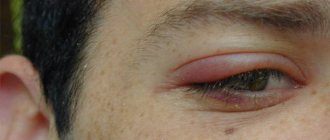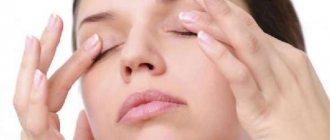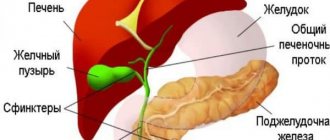Swelling of the eyelids is a common phenomenon that everyone has encountered at least once in their life.
This is due to the fact that the folds of skin that protect the eyes from damage are very thin and delicate, and therefore are susceptible to the influence of negative factors.
Under their influence fluid accumulates in the tissues , they thicken and turn red, and in some cases the patient feels severe itching and discomfort. The clinical picture and treatment features of the disease depend on the factor that provoked it - allergens, pathogenic microorganisms, injuries, pathologies of internal organs.
Odnoklassniki
Symptoms
Before understanding the causes of swelling of the eyelids above the eyes, you need to easily recognize these problems and clearly know what symptoms they are accompanied by.
As a rule, we are talking about burning and irritation of the skin above the eyes, characteristic itching. At the same time, the color of the skin of the eyelids changes, it becomes bluish, darker, or, on the contrary, may turn pale.
Another sure sign that you urgently need to find out why your eyes are swollen above the eyelids is a feeling of tension in the eyelids when closing and painful or uncomfortable sensations when touching them. In addition, capillaries and vessels begin to clearly appear on the surface of the eyelids, in some cases this disease is accompanied by a characteristic small rash.
There are other signs that appear much less frequently. In any case, as soon as you notice swelling of the eyelids above the eyes, you need to take immediate action. The sooner you consult a doctor for qualified help, the faster you can solve the problem.
Causes of swollen eyelids
Swelling of the lower eyelid can be the result of physiological or pathological factors. Physiological reasons are external negative influences; let’s present a list of such factors.
- Constant lack of sleep and overwork leads to a decrease in blood pressure, narrowing of blood vessels, the outflow of blood is disrupted, and as a result, the lower eyelids of the eyes swell. If the cause of edema is poor blood flow, the patient experiences the following changes: dryness, skin color changes and swells, becoming cyanotic, and the bluish marble pallor of the skin is striking.
- A banal violation of hygiene rules. If you rub your eyes with dirty hands, germs will accumulate under the lower eyelid. When an infection occurs, the eyelid may swell, in which case the person feels that the eyelid under the eye hurts.
- The use of cosmetics (if the product is of poor quality, expired, or the patient experiences an allergic reaction to any of the components) can lead to swelling of the lower eyelid.
- An unpleasant symptom of swelling may appear after eyelash extensions or tattooing if the artist has not disinfected the tools or hands. In addition, the tool used for extensions can cause injury.
- An excess of fluid in the body (the daily norm is no more than 2 liters) can lead to swelling.
- A bruise or insect bite often causes swelling and swelling of the lower eyelid of one eye.
- Vitamin deficiency, lack of certain microelements.
Note! Due to these reasons, not only swelling, swelling, but also peeling may appear. Pathological causes are associated with diseases of non-infectious origin, most often the following:
Pathological causes are associated with diseases of non-infectious origin, most often the following:
- Kidney pathologies can cause swelling not only of the lower eyelids, but also of the abdomen, legs, and face. In addition, patients experience pain in the lower back and a general deterioration in well-being.
- Disorders of the cardiovascular system provoke swelling of the eyelids. Patients notice swelling in the evening.
- Hormonal imbalance. In this case, the swelling of the lower eyelid is not severe; mood swings and unsteadiness are a concern.
- Gynecological diseases.
Edema that arises from “internal sources” is less responsive to treatment; it can only be completely eliminated with the help of a specialist
It is important to find out why the lower eyelids swell before starting treatment, because the specifics of therapy largely depend on the cause
Types of edema
Swelling of the eyelids above the eyes can be of several types. As a rule, these are inflammatory, non-inflammatory and allergic.
With inflammatory edema, a large amount of pus is observed, which is constantly released. They occur due to bacteriological pathologies, which is why the eyelids swell above the eyes. It should be noted that most often inflammatory processes are characterized by the accumulation of pus secreted in the glands of the organs of vision. If you ignore such symptoms, you risk developing the disease, causing a serious illness.
Non-inflammatory edema differs from the first category in less pronounced symptoms. If you cannot understand why the eyelids above your eyes swell in the morning, then most likely it is because of them. Such swelling is usually bilateral, affecting both eyes. In this case, the cause of swelling of the eyelids above the eyes lies in the development of some pathology, for example, a disease of the internal organs, possibly the liver, or accumulation of fluid in the area around the eye.
Allergic swelling appears as a result of contact of the mucous membranes of the eye with allergens of various origins. For example, when direct contact occurs, the development of swelling can occur within a few minutes. But if the allergen enters the body indirectly, for example, with liquid, food or various medications, then the effect may appear only after a few hours.
It is believed that this type of pathology is the most severe; moreover, it is accompanied by a significant deterioration in the general condition, the occurrence of severe headaches, and the swelling itself can spread not only to the eyes, but to the entire face. In this case, the causes of swelling of the eyelids above the eyes should be determined immediately in order to provide the patient with qualified and timely assistance.
When do the upper and lower eyelids swell during inflammatory processes?
Inflammatory swelling occurs due to pathogenic microorganisms . Most often, this symptom occurs during infectious processes in the tissues of the eyes, less often - during other diseases (ARVI, influenza, tonsillitis, etc.).
Viruses
In viral diseases, swelling of the eyelids develops as a result of rhinitis due to dilation of the blood vessels in the eyes. This condition is accompanied by copious secretion of mucus from the nasal passages, redness and inflammation of the eyes, and rarely – itching and discomfort when pressed.
Bacterial infection
With bacterial infections, the clinical picture is usually more pronounced than with viral infections.
Patients experience severe swelling of the soft tissues of the upper and lower eyelids, itching, as well as mucous or purulent discharge from the eyes.
Ophthalmic diseases
Inflammatory eye diseases (conjunctivitis, blepharitis, abscesses, phlegmon) are caused by staphylococci, streptococci, gonococci fungi act as causative agents With these pathologies, swelling of the eyelids, discomfort, itching and other symptoms are accompanied by visual disturbances, rapid eye fatigue and redness of the conjunctiva.
Reference! Inflammatory processes in the tissues of the eyes, caused by bacteria or viruses , most often begin on one side, after which they can spread to the other eye.
Diagnostics
It is important to remember that if such problems arise, the first thing you need to do is go to an ophthalmologist. Only this specialist will be able to prescribe all the necessary examinations for an accurate diagnosis of the disease that may contribute to the development of such a condition.
In cases where there is no reason to assume that the causes of edema lie in ophthalmological diseases, based on the results of initial examinations and examinations, additional studies are prescribed by other highly specialized specialists.
The list of diagnostic procedures necessarily includes: urine analysis, general and biochemical blood tests, ultrasound examination of the abdominal organs (this should help identify pathologies of the urinary system), electrocardiogram, x-ray of the skull and spine.
Diagnosis and treatment
To answer the question: “Why do the eyelids swell?” timely diagnosis is necessary. Diagnosis occurs visually. To learn more about why the upper eyelids swell, you need to take a urine test to detect kidney disease and a blood test that calculates protein levels. If these procedures are not enough, an ultrasound or computed tomography will need to be performed.
Often, swelling disappears on its own after some time, but in some cases the situation can only get worse. Most often this happens when there is some deviation. In such situations, swelling can occur not only around the eyes, but also in different parts of the body.
Delayed treatment can lead to the following consequences:
- glaucoma;
- fever;
- elephantiasis;
- swelling of the eyeball;
- increased pressure inside the eye;
- serious vision problems (in advanced cases, vision may disappear altogether).
So how to treat swelling of the eyelids in the morning? First you need to identify the cause of this phenomenon. In case of an allergic reaction, the left or right eyelid will stop swelling after the allergen is eliminated. If the cause is illness, then the swelling will go away when the person recovers. In the case of swelling from an insect bite or wound, everything goes away after healing. Fluid absorption can be accelerated using the following methods:
- Drug treatment, physiotherapy, mesotherapy. To eliminate swelling using these methods, you must first coordinate your actions with your doctor. Only a specialist will tell you whether such procedures are worth carrying out or not.
- Cosmetics (various masks, creams and lotions).
- Massages that can help remove excess fluid and restore the functioning of the lymphatic system.
- Folk remedies taken externally or internally.
The goal of each treatment course is to eliminate inflammatory processes and improve blood circulation, as well as stimulate metabolism.
Possible reasons
When such a disease occurs, it is important to understand its causes. The eyelids above the eyes swell due to a variety of diseases. Moreover, swelling of the upper eyelid is not always a consequence of some illness. Sometimes swelling above the eyes occurs due to improper distribution of fluid in your body in too hot weather. In this case, it is not just the eyelids that swell, but the entire face, as well as the limbs, which is the most characteristic symptom.
There are other explanations for when the eyelids above the eyes swell in the morning. The reasons can often be hidden in eating a large amount of spicy or salty foods or dishes immediately before bed, even in the wrong position of the head relative to the body during sleep. If you remain in this position for a long enough time, the fluid in the body is distributed unevenly, and a significant amount of it flows to the eyelids.
And this is not all that causes swelling of the eyelids above the eyes. The reasons may lie in stress, prolonged overexertion, fatigue and lack of sleep, and alcohol abuse. In the latter case, there is a violation of the fluid balance in the body, which causes the concentration of a significant amount of moisture in the eye area. Another reason may be a violation of the drinking regime, when the body receives significantly less fluid than it actually needs. When there is a lack of moisture, the body begins to independently accumulate it in different parts of the body, one of which is the eyelids.
Please note that we have listed only so-called non-clinical causes that provoke exclusively short-term swelling. In most cases, when edema occurs for these reasons, no treatment is required, and when the underlying cause is eliminated, the swelling itself will go away. However, there are diseases, and quite serious ones, due to which such problems can arise. Now it is necessary to fight them with the help of medications prescribed by the doctor. The causes and treatment of swelling of the eyelids above the eyes will be discussed further in this article.
In newborns
Swelling of the eyelids in newborns is observed for the same reasons as in adults. However, it should be remembered that if in an adult constant swelling may indicate pathology of the liver, kidneys, endocrine and cardiovascular systems, then in children swelling is primarily observed with congenital heart pathologies. Swelling often occurs due to prolonged crying or allergies to food, baby care products, clothing, or feeding formula. Often the face swells when teething.
Swelling of one of the eyelids (usually the lower) is the main symptom of stye, a widespread disease among children. Due to the localization of the inflammatory process at the roots of the eyelashes, significant swelling of the eyelids is observed. Damage to the ocular mucosa is rarely observed. The nearest lymph nodes are involved in the process (they become enlarged and hurt). Without treatment, an abscess forms at the site of maximum swelling, which resolves on its own after 2-4 days with the release of pus and necrotic masses. After resolution, the symptoms go away on their own.
Important! If swelling does not go away after eliminating its possible cause or progressively increases, you need to seek help from a pediatrician. Only a specialist knows for sure what to do in such a situation. Self-medication and seeking help from non-specialists can harm the child’s health.
Diseases
You should especially be wary of pathological edema of the upper eyelid. They happen when this disorder is provoked by some fairly serious disease. One of the most common ailments in this case is blepharoconjunctivitis. This is a very unpleasant disease that simultaneously combines conjunctivitis, that is, inflammation of the mucous membrane of the eye, with blepharitis - the so-called inflammation of the edge of the eyelid.
In the morning, the eyelids above the eyes swell due to hemophthalmos. This is a vitreous hemorrhage that occurs as a result of other eye diseases. It is worth noting that this violation in itself is extremely rare. When it occurs, the blood vessels are affected, including part of the circulatory system, which is located in the area of the upper eyelid.
Another disease that often causes these symptoms is conjunctivitis. Perhaps this is the most common ailment among most age groups, when the mucous membrane of the eye is affected as a result of infectious or non-infectious causes. In such a situation, the eyelids acquire a pronounced red color and become very swollen. Additional symptoms that will help accurately identify this disease are bacterial, allergic and viral causes.
Eyelids may swell due to trachoma, a chronic disease caused by chlamydia. Especially in the early stages, symptoms are extremely poorly developed, and may be completely absent. In this case, swelling of the eyelids may appear as a last resort.
You should be wary of such a disease as eye tuberculosis. This is a tuberculosis disease caused by the tuberculosis bacillus. This pathology usually develops independently and is considered a complication of pulmonary tuberculosis.
Finally, another cause of swelling above the eyes is endophthalmitis. This is an inflammatory disease that spreads to the internal structures of the human visual organs. As a result, purulent discharge accumulates in large quantities in the glands and tissues of the eyes, which are located directly in the eyelids. During this disease, the patient's vision may be significantly impaired, with pronounced swelling, the eyelids thicken, acquiring a pronounced red tint.
Causes of swelling of the upper eyelids
Over time, many people get used to the fact that they are used to seeing a flushed face with swollen eyelids in the mirror in the morning. The swelling often goes away within a day, and they do not perceive eye swelling as a serious illness.
Of course, you shouldn’t panic, but it’s often necessary to see a doctor. The causes of swelling of the upper eyelids are varied. These may be trivial factors, or there may be serious pathology present.
The most common causes of eyelid swelling are the following:
- Allergic reaction of the body to irritants
- Inflammation of the eyes due to bacterial infection
- Viral infection
- Diseases of internal organs: kidneys, liver, lungs or heart
- Trauma to the eye or eyelid itself
- Bad habits
- Stress and overwork
- Dermatitis
- Prolonged tearing
It happens that swelling of the upper eyelid is caused by an insect bite. And sometimes a small scratch can lead to severe deformation and swelling of the eyelid.
If there is no obvious cause for eye swelling, then the factor must be looked for in the deep hidden corners of the body, conducting research and diagnostic measures.
The development of puffiness can be given impetus by a hereditary predisposition, which is a depleted membrane between the subcutaneous tissue and the skin. Over time, the membrane becomes even thinner. In this case, any illness or stress causes swelling of the upper eyelid.
Any cold, prolonged runny nose and cough, causing vasodilation, can trigger the appearance of edema.
Quite often, swelling of the upper eyelid can be caused by eye disease:
- Blepharitis (inflammation of the eyelid)
- Dacryocystitis (inflammation of the lacrimal gland)
- Furunculosis
- Phlegmon
- Endophthalmitis
- Pseudotumor
- Meybovit
- Abscess of the eye
Conventionally, edema is classified according to the nature of its course:
- Inflammatory, when there is redness, conjunctivitis, increased body temperature, suppuration.
- Non-inflammatory, in which swelling is clearly expressed only in the morning, on both eyelids.
Why does only one eyelid swell?
As a rule, the overwhelming majority of ophthalmic pathologies are bilateral. This is especially true for those caused by pathogenic microorganisms. In such cases, both eyes are immediately affected.
But in some cases, swelling appears only in one eye. As a rule, this occurs as a result of colds that are of infectious origin.
It is also worth noting that swelling of only one eye is considered a classic manifestation of allergic dermatitis when the allergen comes into direct contact with human skin.
Having arisen in the upper eyelid of one eye, the swelling subsequently spreads across the face, but only in one half of it. As a rule, he cannot switch to another one.
One of the most common causes of unilateral swelling is insect bites or injuries. That is, in this case we are talking about exclusively local damage that does not have the opportunity to spread further over the surface.
Such swelling is most often short-lived, and with timely and qualified first aid, the symptoms disappear within a few days.
If a person has an allergic reaction to insect venom, the swelling may persist for a longer period, but everything will go away without consequences for the body.
Morning swelling of the eyelids
Swelling is not always the result of serious illnesses. Morning swelling of the eyelids is a common phenomenon for many people, not only those who have serious health problems.
These may be trivial reasons:
- Lack of sleep
- Overwork
- Prolonged lack of sleep
- Late dinner
- Large volume of liquid drunk
- Excess salt in the body and food consumed
- Taking a hot bath before bed
- Incorrect posture during sleep
- Prolonged crying
- Frequent smoking at night
- The use of creams that cause an allergic reaction
Often it is enough to eliminate such factors and the swelling of the eyelids will go away without the use of medications or other home measures. A healthy lifestyle and following the recommendations of a doctor and cosmetologist will help eliminate the problem.
Treatment methods
Treatment for swelling of the eyelids above the eyes depends on the reasons why this problem arose. At the same time, it is strictly not recommended to treat edema symptomatically without understanding its causes. In order to accurately diagnose the disease, you need to undergo a full examination by a doctor.
As a rule, regardless of the disease itself, the doctor will prescribe topical decongestants to remove swelling of the eyelids above the eyes quickly and effectively. In this case, decongestants can be of various types - ointments or creams, in most cases they quickly help eliminate the symptom itself. But you shouldn’t limit yourself to just these drugs. The main thing is to understand the reasons and eliminate them. In addition to the use of external agents, you must adhere to the course of treatment prescribed by your attending physician and take medications depending on the pathology diagnosed in you.
Barley
If we dwell on the causes of swelling of the eyelids, then one of the most common is stye. With this disease, as a rule, the upper eyelid becomes swollen and inflamed. In some cases, an abscess may form above the eye, and sometimes it appears on the lower eyelid.
It is believed that the most rational way in this case is to wait until the abscess opens on its own in order to stimulate it; in addition to this, you can use warming, and throughout the entire time you have barley, use anti-inflammatory drugs.
The situation will worsen significantly if barley begins to develop not from the outside, but from the inside of the eyelid. In such a situation, ointments must be applied from the inside, which causes discomfort and pain to the patient.
In such cases, instillation of special ophthalmic solutions is often used, which have not only a disinfecting, but also an anti-inflammatory effect. Indeed, if the abscess is opened, its contents will end up on the mucous membrane of the eye, which can lead to the development of inflammation.
Treatment of edema
Treatment of edema often comes down to treating the underlying disease and eliminating the causes of its appearance. Each type of swelling requires an individual approach. It's worth highlighting them.
Treatment of inflammatory edema requires the use of:
- Antibiotics
- Antiviral drugs
- Physiotherapy
- Washing with special solutions
- Pain relief medications
- Anti-inflammatory drugs
To treat traumatic edema, you need:
- Treatment of the injured area with special compounds
- Treatment of injury
- Cooling
- Prevention of infection
Therapeutic measures in the treatment of allergic edema of the eyelids are:
- Antihistamines
- Hormonal treatment
- Eliminating the allergen
When treating non-inflammatory edema, you should:
- Determining the causes underlying swelling
- Diuretics
- Lymphatic drainage massage
- Cold compresses
- Following a certain salt-free diet
- Sometimes surgery is required
As you age, it is impossible to remain absolutely healthy - time and aggressive environmental influences negatively affect your overall health. The result is obvious. One such result is swelling of the eyes.
Conjunctivitis
With conjunctivitis, swelling occurs of varying degrees of severity. It all depends on the origin and causes of the disease. It is believed that the most invisible is swelling of the upper eyelid due to bacterial conjunctivitis.
In these cases, drugs are often used that simultaneously have a decongestant and antibacterial effect. These include tetracycline ointment, picloxidine, ciprofloxacin, erythromycin, gentamicin ointment, levomiticin, ofloxacin, albucid.
For blepharoconjunctivitis, both drug and local therapy are used. In particular, we are talking about corticosteroids, antiviral, antihistamines, and antibacterial drugs. Regular eye washing with herbal infusions and decoctions with an antiseptic solution has proven its effectiveness.
Prevention
There are several ways to avoid non-pathological eye swelling or reduce the likelihood of its occurrence. You just have to follow a few simple rules. It is important to carefully and scrupulously follow the rules for storing and wearing contact lenses and change them in a timely manner as soon as the product expires.
It is not recommended to eat spicy, salty, fried foods immediately before bed, or drink large amounts of liquid. In spring and autumn, vitamin complexes should be taken to strengthen the immune system. It is important to monitor your body’s reaction to all kinds of allergens and avoid contact with those that harm your body.
Also, carefully monitor the health of your eyes and carefully observe the rules of personal hygiene. Please note that if you notice the first signs of an ophthalmic disease, you should immediately contact a qualified specialist.
It is important for people over the age of 35 to undergo regular check-ups to rule out pathological problems, which may be asymptomatic in the early stages of the disease. It is worth getting examined at least once a year.












